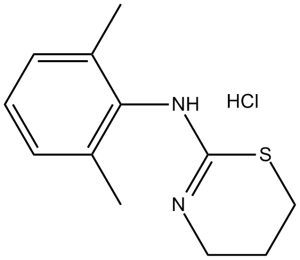This product is for research use only, not for human use. We do not sell to patients.

| Size | Price | Stock |
|---|---|---|
| 5g | $450 | Check With Us |
| 10g | $650 | Check With Us |
| 20g | $975 | Check With Us |
Cat #: V1080 CAS #: 23076-35-9 Purity ≥ 98%
Description: Xylazine HCl (Anased; BAY 1470; BAY-1470;Primazine; Rometar; Sedomin; WH-7286; Xilazina), the hydrochloride salt of xylazine and an analogue of clonidine, is an α2-Adrenergic receptor agonist that has been approved as a Veterinarian drug and used for sedation, muscle relaxation, anesthesia, and analgesia in big animals such as horses, cattles and other non-human mammals.
Publications Citing InvivoChem Products
Product Promise

- Physicochemical and Storage Information
- Protocol
- Related Biological Data
- Stock Solution Preparation
- Quality Control Documentation
| Molecular Weight (MW) | 256.79 |
|---|---|
| Molecular Formula | C12H16N2S.HCl |
| CAS No. | 23076-35-9 |
| Storage | -20℃ for 3 years in powder formr |
| -80℃ for 2 years in solvent | |
| Solubility In Vitro | DMSO: 50 mg/mL (194.7 mM)r |
| Water: 12 mg/mL (46.73 mM)r | |
| Ethanol: 50 mg/mL (194.7 mM) | |
| Synonyms | BAY-VA 1470; BAY1470; Anased; BAY 1470; BAY-1470; Xylazine hydrochloride; Primazine; Rometar; Sedomin; WH 7286; Xilazina |
| Protocol | In Vivo | Xylazine (5.2 mg/kg; intraperitoneal injection; for 10-60 minutes; male Sprague-Dawley rats) administration alters mRNA expression and protein phosphorylation levels of AMPK signaling molecules, suggesting that the LKB1-AMPK pathway plays a role in the sedative and tranquilizing effects in the CNS caused by Xylazine treatment |
|---|---|---|
| Animal model | Male Sprague-Dawley rats (160-180 g) | |
| Dosages | 5.2 mg/kg | |
| Administration | Intraperitoneal injection; for 10 minutes, 20 minutes, 40 minutes or 60 minutes |
| Solvent volume to be added | Mass (the weight of a compound) | |||
|---|---|---|---|---|
| Mother liquor concentration | 1mg | 5mg | 10mg | 20mg |
| 1mM | 3.8942 mL | 19.4712 mL | 38.9423 mL | 77.8847 mL |
| 5mM | 0.7788 mL | 3.8942 mL | 7.7885 mL | 15.5769 mL |
| 10mM | 0.3894 mL | 1.9471 mL | 3.8942 mL | 7.7885 mL |
| 20mM | 0.1947 mL | 0.9736 mL | 1.9471 mL | 3.8942 mL |
This equation is commonly abbreviated as: C1 V1 = C2 V2
- (1) Please be sure that the solution is clear before the addition of next solvent. Dissolution methods like vortex, ultrasound or warming and heat may be used to aid dissolving.
- (2) Be sure to add the solvent(s) in order.




































